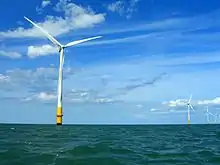Offshore construction
Offshore construction is the installation of structures and facilities in a marine environment, usually for the production and transmission of electricity, oil, gas and other resources. It is also called maritime engineering.

.jpg.webp)
Construction and pre-commissioning is typically performed as much as possible onshore. To optimize the costs and risks of installing large offshore platforms, different construction strategies have been developed.
One strategy is to fully construct the offshore facility onshore, and tow the installation to site floating on its own buoyancy. Bottom founded structure are lowered to the seabed by de-ballasting (see for instance Condeep or Cranefree), whilst floating structures are held in position with substantial mooring systems.
The size of offshore lifts can be reduced by making the construction modular, with each module being constructed onshore and then lifted using a crane vessel into place onto the platform. A number of very large crane vessels were built in the 1970s which allow very large single modules weighing up to 14,000 tonnes to be fabricated and then lifted into place.
Specialist floating hotel vessels known as flotels are used to accommodate workers during the construction and hook-up phases. This is a high cost activity due to the limited space and access to materials.
Oil platforms are key fixed installations from which drilling and production activity is carried out. Drilling rigs are either floating vessels for deeper water or jack-up designs which are a barge with liftable legs.[1] Both of these types of vessel are constructed in marine yards but are often involved during the construction phase to pre-drill some production wells. Other key factors in offshore construction are the weather window which defines periods of relatively light weather during which continuous construction or other offshore activity can take place. Safety is another key construction parameter, the main hazard obviously being a fall into the sea from which speedy recovery in cold waters is essential.
The main types of vessels used for pipe laying are the "derrick barge (DB)", the "pipelay barge (LB)" and the "derrick/lay barge (DLB)" combination. Diving bells in offshore construction are mainly used in water depths greater than 120 feet (40 m), less than that, the divers use a wet bell or Diving stage, a metal basket deployed from a launch and recovery system (LARS, or "A" frame) on the deck. The basket is lowered to the working depth. Closed bells can go to 1,500 feet (460 m), but are normally used at 400 to 800 feet (120 to 240 m).
Offshore construction includes foundations engineering, structural design, construction, and/or repair of offshore structures, both commercial and military.
Outline
See also
- Fluid mechanics – Branch of physics concerned with the mechanics of fluids (liquids, gases, and plasmas) and the forces on them; branch of continuum mechanics
- Hydraulic engineering – Sub-discipline of civil engineering concerned with the flow and conveyance of fluids
- Hydrology – The science of the movement, distribution, and quality of water on Earth and other planets
- Maritime archaeology – archaeological study of human interaction with the sea
- Marine biology – The scientific study of organisms that live in the ocean
- Oceanography – The study of the physical and biological aspects of the ocean
- Offshore (disambiguation)
- Offshore geotechnical engineering – A sub-field of engineering concerned with human-made structures in the sea
- Offshore survey – Discipline of hydrographic survey primarily concerned with the oil industry
- Rheology – Study of the flow of matter, primarily in a liquid state
- Very large floating structure
- Artificial island – An island constructed by people
- Underwater habitat – Human habitable underwater enclosure filled with breathable gas
- Ocean development
- Ocean colonization – A type of ocean claim
- Underground construction
References
- Bevan, John, ed. (2005). The Professional Divers's Handbook (second ed.). 5 Nepean Close, Alverstoke, GOSPORT, Hampshire PO12 2BH: Submex Ltd. ISBN 978-0950824260.CS1 maint: location (link)
- An Overview of Design, Analysis, Construction and Installation of Offshore Petroleum Platforms Suitable to Cypress/Oil Gas Fields by Kabir Sadeghi, GAU, J. Soc. & Appl. Sci., 2(4), 1–16, 2007
- OFFSHORE VN (31 October 2013). "Significant Guidance for Design and Construction of Marine and Offs". Slideshare.net.
| Wave power |  | |
|---|---|---|
| Tidal power | ||
| Other | ||
| ||
